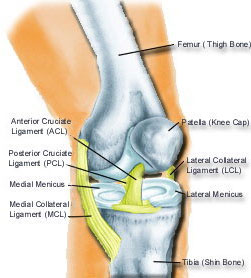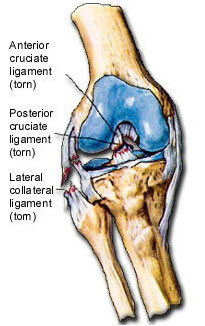Knee Pain and Injuries

Anatomy of the Knee
The knee joint is a junction of three bones. The femur and the tibia meet to form a hinge joint. In front of them is the patella (kneecap). The patella sits over the other bones and slides when the leg moves.
The ends of the three bones are covered with articular cartilage. This is a tough elastic material that basically cushions the joint. Also helping to cushion the knee are two C-shaped pads of cartilage called menisci. They lie between the tibia and the femur. There is a lateral meniscus and a medial meniscus.
Ligaments help to stabilize the knee. These are strong elastic bands of tissue that connect one bone to another. The four main stabilizing ligaments of the knee are the anterior cruciate ligament (ACL), posterior cruciate ligament (PCL), medial collateral ligament (MCL), and lateral collateral ligament (LCL).
There are two basic groups of muscles at the knee. In the front of the knee are the quadriceps muscles that work to straighten the leg out. In the back of the knee are the hamstring muscles which help to flex the knee.
The anterior cruciate ligament (ACL) is important for knee stabilization. This is located deep inside the knee joint.

Anatomy of the Knee
The ACL helps control how far the tibia can move in relationship to the femur. Injuries to the ACL are very common and most of the time are sports related.
The sports requiring the foot to be planted and the body to change directions rapidly, such as basketball, are associated with a higher incidence of injury.
Usually injury will occur to the ACL with a sudden hyperextension or rotational force. Depending on the activity or sport the mechanism may differ somewhat.
Soccer, skiing and football are also three common sports where ACL injuries occur. Often the injured athlete will feel a “pop” in the knee and have sudden pain.
The athlete may or may not fall to the ground. Skiers will usually fall. However, a soccer player or basketball player in mid-stride stopping suddenly and pivoting can suffer an ACL tear and still often be able to ambulate.
Besides the pop, the knee often swells after an ACL injury.
It is not uncommon for multiple knee structures to be hurt in an injury. An ACL, MCL and lateral meniscal injury is a common “triad.”
Activities requiring rotational motion about the knee, including twisting, cutting and jumping sports, are not recommended after an ACL tear because of the risk of cartilage damage.
The orthopedic community has realized over the last several years that long term instability of the knee can lead to early arthritis.
Some activities, however, can be continued with an ACL lax knee. These are “in-line” sports such as bicycling, light jogging, roller blading and swimming.